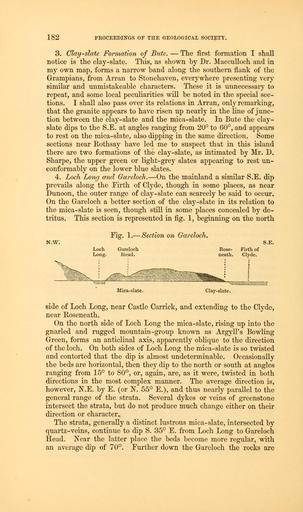MAKE A MEME
View Large Image

| View Original: | The_Quarterly_journal_of_the_Geological_Society_of_London_(12645713935).jpg (1226x2069) | |||
| Download: | Original | Medium | Small | Thumb |
| Courtesy of: | commons.wikimedia.org | More Like This | ||
| Keywords: The Quarterly journal of the Geological Society of London (12645713935).jpg 182 PROCEEDINGS OF THE GEOLOGICAL SOCIETY <br> 3 Clay-slate Formation of Bute ” The first formation I shall <br> notice is the clay-slate This as shown by Dr Macculloch and in <br> my own map forms a narrow band along the southern flank of the <br> Grampians from Arran to Stonehaven everywhere presenting very <br> similar and unmistakeable characters These it is unnecessary to <br> repeat and some local peculiarities will be noted in the special sec- <br> tions I shall also pass over its relations in Arran only remarking <br> that the granite appears to have risen up nearly in the line of junc- <br> tion between the clay-slate and the mica-slate In Bute the clay- <br> slate dips to the S E at angles ranging from 20° to 60° and appears <br> to rest on the mica-slate also dipping in the same direction Some <br> sections near Rothsay have led me to suspect that in this island <br> there are two formations of the clay-slate as intimated by Mr D <br> Sharpe the upper green or light-grey slates appearing to rest un- <br> conformably on the lower blue slates <br> 4 Loch Long and Gareloch ” On the mainland a similar S E dip <br> prevails along the Eirth of Clyde though in some plaees as near <br> Dunoon the outer range of clay- si ate can scarcely be said to occur <br> On the Gareloch a better section of the clay-slate in its relation to <br> the mica-slate is seen though still in some places concealed by de- <br> tritus This section is represented in fig 1 beginning on the north <br> Eig 1 ” Section on Gareloch <br> N W S E <br> Loch Gareloch Rose- Firth of <br> Long Head neath Clyde <br> Mica-slate Clay-slate <br> side of Loch Long near Castle Carrick and extending to the Clyde <br> near Roseneath <br> On the north side of Loch Long the mica-slate rising up into the <br> gnarled and rugged mountain -group known as Argyll's Bowling <br> Green forms an anticlinal axis apparently oblique to the direction <br> of the loch On both sides of Loch Long the mica-slate is so twisted <br> and contorted that the dip is almost undeterminable Occasionally <br> the beds are horizontal then they dip to the north or south at angles <br> ranging from 15° to 80° or again are as it were twisted in both <br> directions in the most complex manner The average direction is <br> however N E by E or N 55° E and thus nearly parallel to the <br> general range of the strata Several dykes or veins of greenstone <br> intersect the strata but do not produce much change either on their <br> direction or character <br> The strata generally a distinct lustrous mica-slate intersected by <br> quartz-veins continue to dip S 35° E from Loch Long to Gareloch <br> Head Near the latter place the beds become more regular with <br> an average dip of 70° Further down the Gareloch the rocks are 35328143 109632 51125 Page 182 Text v 19 http //www biodiversitylibrary org/page/35328143 1863 Geological Society of London Biodiversity Heritage Library The Quarterly journal of the Geological Society of London v 19 1863 Geology Periodicals Smithsonian Libraries bhl page 35328143 dc identifier http //biodiversitylibrary org/page/35328143 smithsonian libraries Information field Flickr posted date ISOdate 2014-02-20 Check categories 2015 August 26 CC-BY-2 0 BioDivLibrary https //flickr com/photos/61021753 N02/12645713935 2015-08-27 10 51 41 cc-by-2 0 PD-old-70-1923 The Quarterly journal of the Geological Society of London 1863 Photos uploaded from Flickr by Fæ using a script | ||||